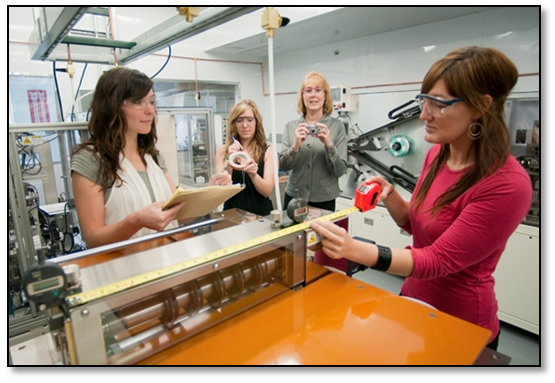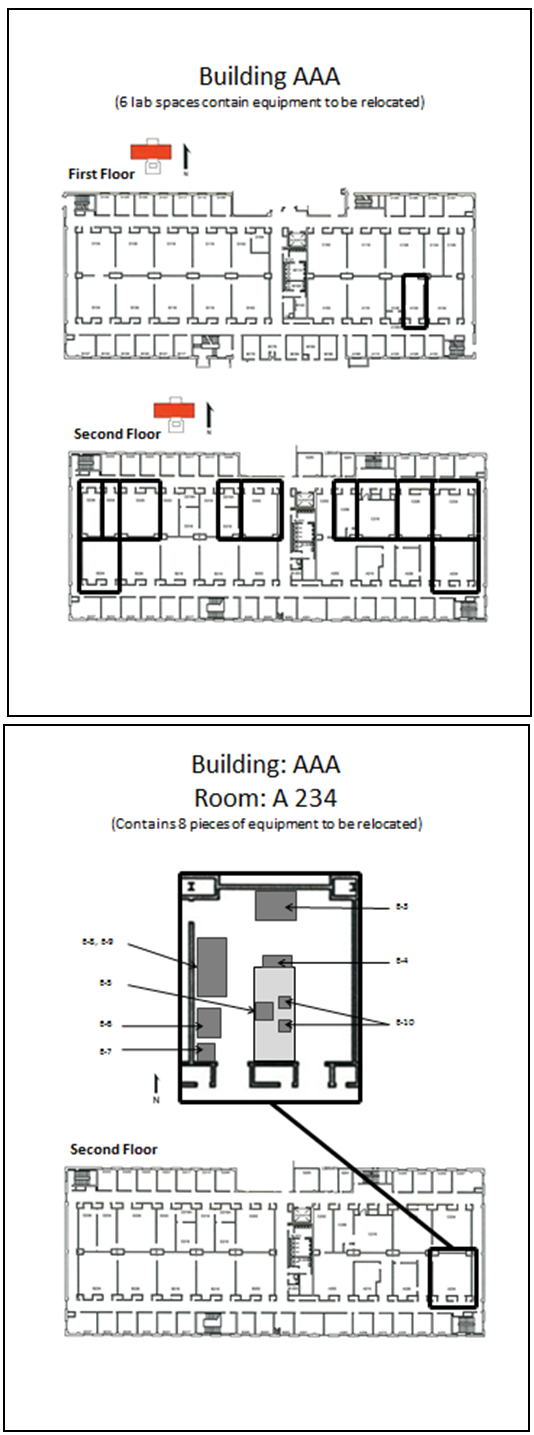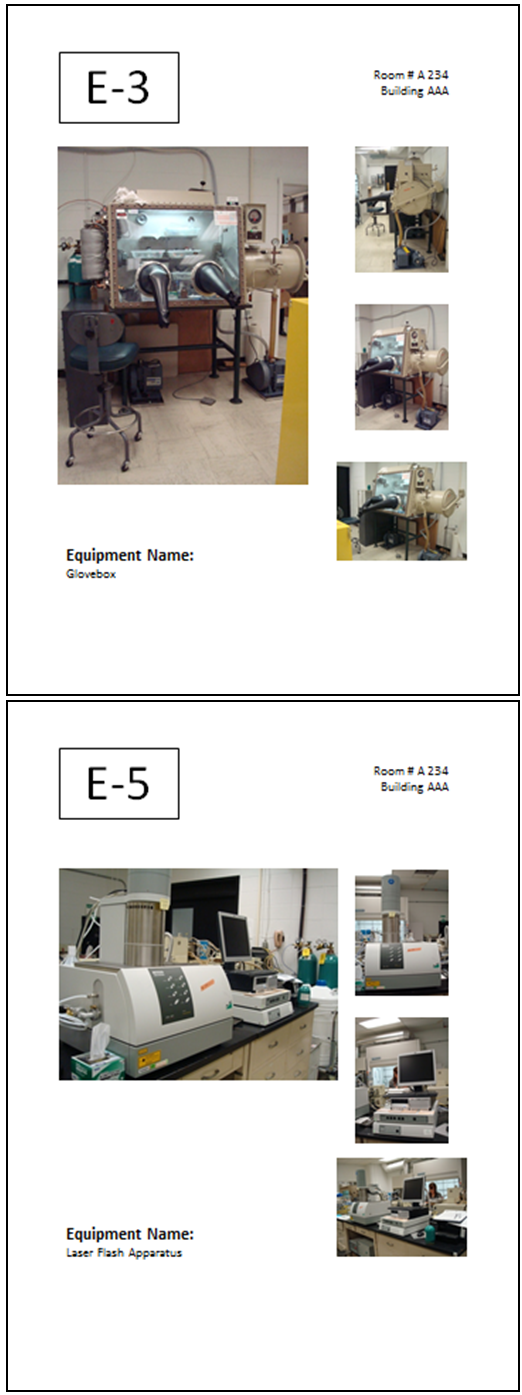-
Paper Information
- Next Paper
- Paper Submission
-
Journal Information
- About This Journal
- Editorial Board
- Current Issue
- Archive
- Author Guidelines
- Contact Us
Management
p-ISSN: 2162-9374 e-ISSN: 2162-8416
2015; 5(2): 34-39
doi:10.5923/j.mm.20150502.02
Facilitating Move Management: Examining Existing Equipment at a National Laboratory
Paulette R. Hebert, Mihyun Kang
Department of Design, Housing and Merchandising, Oklahoma State University, Stillwater, USA
Correspondence to: Mihyun Kang, Department of Design, Housing and Merchandising, Oklahoma State University, Stillwater, USA.
| Email: |  |
Copyright © 2015 Scientific & Academic Publishing. All Rights Reserved.
Although moves/relocation is one of facility mangers’ responsibilities, studies on move management have been limited. The purpose of this research was to investigate, measure, and document the physical attributes, requirements, and location of existing, large laboratory equipment in order to expedite the impending relocation of the equipment. The researchers conducted survey to collect laboratory equipment data. The location of each piece of equipment was mapped on furniture floor plans. Anecdotal equipment data received from scientists were field-noted and transcribed. Equipment was categorized by type and analyzed using descriptive statistics. 361 pieces of equipment were examined, measured, and photographed in 59 individual laboratory spaces located in 11 divisions within the site. Inventory spreadsheets, which were cross-referenced to a total of 69 building plans, 37 furniture and equipment floor plans and 37 control sheets were developed. The researchers categorized each piece of equipment into the six groups: Analytical, Control, Computer, Furniture, Process and Storage. Control equipment was the largest category, accounting for more than one third of survey pieces. Some equipment was hazardous, expensive, vibration sensitive or required special connections or exhausts; which would require special attention during a move. Some of the equipment labels were worn, damaged, or missing. Some pieces had been modified, combined, or were custom creations. This study contributes to the understanding of laboratory environments’ facility management and design issues.
Keywords: Facility management, Move management, Lab equipment
Cite this paper: Paulette R. Hebert, Mihyun Kang, Facilitating Move Management: Examining Existing Equipment at a National Laboratory, Management, Vol. 5 No. 2, 2015, pp. 34-39. doi: 10.5923/j.mm.20150502.02.
Article Outline
1. Introduction
- Existing large equipment and related equipment furniture, (free-standing specialty cabinets, carts and tables) housed in individual laboratory spaces at a National Laboratory facility, varied in physical attributes and utility requirements. A comprehensive equipment inventory did not exist prior to the current study. This research was considered essential, as it was anticipated to inform an upcoming move. The equipment in many labs would be relocated to a new on-site lab facility.As part of a larger study, the purpose of this research was to investigate, measure, and document the physical attributes, requirements, and location of existing, large laboratory equipment in order to expedite the impending relocation of the equipment. A facility management research team, consisting of three undergraduate University interns and one Professor, examined the equipment in situ at a National Laboratory facility as part of their participation in a federally funded summer work program.Although the majority of facility managers (n= 3139, 63%) reported that one of their current responsibilities was “moves/relocations” there have been only a limited number of scholarly articles, which address this topic [1]. Even fewer address moving equipment. This research is anticipated to fill a gap in move management literature.
2. Field Studies of Equipment
- Previous researchers have performed field studies of equipment in various settings including those in residential, medical, farm, office, and scientific applications for the purposes of determining safety defects, identifying associated protocols, determining energy consumption and power characteristics, examining the maintenance feasibility or policies, improving reliability, studying waste production, planning for future acquisitions, and benchmarking [2-11]. Others have considered the vulnerability of laboratory equipment and furniture to the vibrations caused by seismic activity [12] but vibrations may also cause damage during a move [13].Scadden and Mitchell [14] reported that “facility decommissioning may include….equipment dismantling… [which] also need[s] certain levels of documentation” (p. 8). These authors have described equipment surveys as “important to determine the equipment and materials present inside a building before it can be decommissioned.” (p. 5). Further,”… equipment inventory can support the development of process knowledge, and it is also a consideration for remediation and dismantling from both a cost and logistical perspective.” (p. 5). Scadden and Mitchell [14] also indicated that “The level of detail for an equipment inventory can vary greatly, from a simplistic assessment describing that there is a building of a certain size filled with a particular type of equipment, to a detailed listing of every piece and size of item in place. This information should be incorporated into the cost evaluation for the decommissioning options so a greater level of detail in the inventory is beneficial for the accuracy of the cost comparison.” (p. 5). Tehrani, Ajoku, & Dioguardi [15] also suggested that equipment inventories should be performed for move management. For the purposes of planning for relocations, some have also field-examined equipment, photo-documented equipment in situ, and field-documented the area surrounding the equipment [16]. Equipment surveys for educational/academic/research institutions have been performed by previous researchers, some of who mailed questionnaires to end-users for self-administration [17]; [18]. Willet and Green [19] advocated the use of computer programs such as AutoCAD in developing inventories prior to a move.
3. Laboratories as Shelters (Sanctuaries) for Equipment
- In the past, laboratories were seen as special places which housed high densities of valuable equipment. This equipment was indispensible to scientists who flocked to laboratories to engage in experiments, sometimes with their colleagues. However, that paradigm is changing somewhat in situations where technology can support scientists’ collaborations from afar and facilitate the sharing of equipment located remotely [20]. Some in the educational sphere have also promoted virtual laboratories to hedge against the lack of laboratory equipment [21]; [22], the constraints and costs of laboratories [23]; [24], and the safety concerns associated with traditional laboratories [25]. The value of virtual labs has been advocated in potentially supplementing [21] or even replacing [23]; [24] traditional laboratories as well as in providing for distance learning [21].However, in other places, laboratories still physically house both scientists and their equipment. Jindal-Snape and Snape [26] showed that scientists could be motivated by “laboratory refurbishment” and “new equipment”. In 2005, Sims performed an ethnographic case study of two working laboratories. He performed field observations and conducted interviews of laboratory end-users. He offered the following description of one of the labs: “This space is filled with a complex, interconnected collection of scientific equipment that is difficult to make sense of at first” [27].
4. Laboratory Equipment, Processes and Danger
- In speaking of the dangers inherent in some laboratories, Sims [27] described safety issues related to equipment as “issues of risk and safety can also be an integral part of the practice of science (p. 333). Sims also said “…the set of technical skills and knowledge necessary to make equipment function safely is largely the same as that required to make it produce reliable scientific results.” In safety-critical scientific environments, safety efforts and research work are interdependent processes…” (p. 334). Others have considered the dangerous aspects of work within laboratories including those supporting chemical, electrical and biomedical processes. Authors have warned of the danger of equipment malfunctions [28], hazardous materials [29] and potential injuries from various types of energy [30] which may be found in laboratory environments. Tehrani [31] advised that laboratory moves involve working in a “hazardous material environment” with potential exposures to “chemical, biohazardous, and carcinogenic inventory”.Some pieces of equipment have specific needs for space and stabilization or for various support systems including those for air, water, and special gas connections; power supplies; vacuum supplies; venting; waste; disposal; noise isolation; and vibration isolation [32]; [16]. Deaver and Emery [33] took photographs and notes pre-move when they disassembled equipment in a complex, Western U.S. standards lab in 1999 in order to facilitate reconnection at a new site. Capasso [34] recommends that a company’s “move coordinator… influence equipment plans to ensure success” even in relatively routine office relocations.
5. Procedure
- A four week field study was conducted during the Summer of 2010. The researchers previously attended training session required by the National Laboratory, including those related to hazardous equipment and chemicals and the use of personal protection and equipment while in lab spaces. Researchers were escorted into individual labs by supervising scientists and facility management personnel during this study. Scientists were queried regarding the name and function of various pieces of equipment as well as characteristics and requirements. The purposeful samples of equipment were selected by the end-user scientists (See Figure 1).
 | Figure 1. Examining and documenting equipment in a laboratory Courtesy of National Laboratory |
6. Findings
- During the study, 361 pieces of existing equipment were examined, measured, and photographed in 59 individual laboratory spaces which were located in 11 divisions within the National Laboratory site. Results were entered into inventory spreadsheets which were cross-referenced to a total of 69 building plans, 37 furniture and equipment floor plans and 37 control sheets (See Figure 2 and Figure 3. All figures in this manuscript were edited to ensure laboratory privacy.)
 | Figure 2. Examples of laboratory plans with examined equipment locations |
 | Figure 3. Examples of control sheet |
7. Conclusions and Implications
- This study provided a unique opportunity for facility management interns and University faculty members to contribute towards the move management of a complex, U. S. Federal laboratory facility. During the relatively brief study period allowed for this time-intensive work, the researchers were challenged to acquire all of the relevant information requested about this large collection of specialized scientific equipment. The facility management intern summer work period was limited and laboratory equipment access was sometimes difficult, partly due to ongoing scientific experiments and the hazardous nature of some laboratories. Further, missing equipment data hindered progress. However, the researchers were able to acquire and assemble data into deliverables, which were deemed helpful for the impending lab relocation by the lab’s existing facility managers and the new lab facility’s designers. This research study constitutes an effort to inform a transition plan for a National Laboratory. All data was submitted to and accepted by the National Laboratory’s division of Facility Management Services for potential incorporation into the transition plan and design of new laboratory spaces. This study is anticipated to contribute to the understanding of laboratory environments’ facility management and design issues. The study provides detailed information needed for the impending transition plan, potentially reducing relocation costs and improving the outcome. Equipment requirements such as the need for water or gas connections and where these connections are located have task implications for moves. The pre-move tasks include draining tanks and tubing, dismantled equipment, undoing connections, etc. Appropriate reconnections must be made after the move. Knowing exactly where the equipment and connections are located and the amount of space available for passage will speed these procedures. For the largest pieces of equipment, some walls were constructed at the lab after installation. Demolition will be required prior to the removal of equipment. The current research project is anticipated to inform activities such as these. This method may be adopted by other National Laboratory moves in the future. The proposed inventory will also provide the documentation necessary to support new laboratory designs. Efficient laboratory relocation and lab designs will support scientists and allow for the completion of research tasks with as little disruption of work as possible, in fulfillment of the U.S. Department of Energy’s mission. Previously, relatively few scientific research studies utilizing laboratory equipment and furniture field surveys have been conducted. Currently there is also a dearth of scholarly articles regarding move management. Through dissemination, the proposed study will fill a gap in the body of knowledge regarding the relocation of large lab equipment and furniture. As a more immediate result of this study, was that one of the University interns was offered a full-time job. She is currently a Project Manager in Facility Management Services at the National Laboratory where this research took place.
 Abstract
Abstract Reference
Reference Full-Text PDF
Full-Text PDF Full-text HTML
Full-text HTML